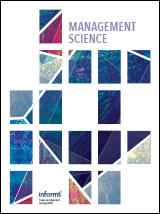Academic articles
Practitioner articles
Working papers
Books
Book chapters
Case studies
Other publications
Subject(s)
Human resources management/organizational behavior
Keyword(s)
hybrid work, return to office, leadership
JEL Code(s)
J81
ISSN (Print)
0015-6914
Subject(s)
Economics, politics and business environment
Subject(s)
Strategy and general management
Keyword(s)
executive education, leadership development, consortial programs, business strategy, peer-to-peer learning, corporate training, innovation and management, geopolitical challenges, global business perspectives, practical knowledge transfer
ISSN (Print)
0015-6914
Subject(s)
Human resources management/organizational behavior
Keyword(s)
negotiation
Copyright 2025 Harvard Business School Publishing Corporation
Pages
237-244
ISBN
9798892790017
Subject(s)
Finance, accounting and corporate governance
Keyword(s)
Learning, tax avoidance, information frictions, taxation and development, bunching, behavioral responses to taxation
JEL Code(s)
D83, H24, H26, H32, O17
Volume
127
Journal Pages
46–78
ISSN (Online)
1467-9442
Subject(s)
Human resources management/organizational behavior
Keyword(s)
innovation, communication, leadership
Subject(s)
Information technology and systems; Management sciences, decision sciences and quantitative methods; Technology, R&D management
Keyword(s)
information design, supply chain management, newsvendor model, forecast sharing
This paper studies an information design problem of a retailer in a two-tier supply chain that procures a single type of product from a supplier. The supplier needs to decide on a production quantity by balancing the shortage cost and the excess inventory holding cost with respect to the retailer’s demand. The retailer’s demand is random but the retailer receives an informative signal about the demand before the supplier sets the production quantity, and places orders after learning the demand realization. The retailer wants to reduce the shortage cost, and to this end she can disclose information about her signal to persuade the supplier to increase production levels. For this setup, we characterize the optimal information disclosure policy of the retailer, and shed light on settings where the retailer strictly benefits from carefully designed information disclosure policies relative to a full- or a no-disclosure policy.
© 2024, INFORMS
ISSN (Online)
1526-5501
ISSN (Print)
0025–1909
Subject(s)
Economics, politics and business environment
Keyword(s)
Market Power, Search and Matching, Wages
JEL Code(s)
J31, J42
Volume
91
Journal Pages
3569–3607
Subject(s)
Economics, politics and business environment
Keyword(s)
Trade platform, hybrid business model, antitrust policy, tax policy
JEL Code(s)
D42, L12, L13, L40, H25
We provide a canonical and tractable model of a trade platform enabling buyers and sellers to transact. The platform charges a percentage fee on third-party product sales and decides whether to be "hybrid", like Amazon, by selling its own product. It thereby controls the number of differentiated products (variety) it hosts and their prices. Using the mixed market demand system, we capture interactions between monopolistically competitive sellers and a sizeable platform product. Using long-run aggregative games with free entry, we endogenize seller participation through an aggregate variable manipulated by the platform's fee. We show that a higher quality (or lower cost) of the platform's product increases its market share and the seller fee, and lowers consumer surplus. Banning hybrid mode benefits consumers. The hybrid platform might favor its product and debase third-party products if the own product advantage is sufficiently high. We also provide some tax policy implications.
© 2024 The Author(s). The RAND Journal of Economics published by Wiley Periodicals LLC on behalf of The RAND Corporation.
Volume
55
Journal Pages
684–718
Subject(s)
Strategy and general management; Technology, R&D management
Keyword(s)
deep-tech innovation, lean startup, science-based innovation, biotechnology, space technology, material science, quantum computing
JEL Code(s)
O32
ISSN (Print)
0017-8012

